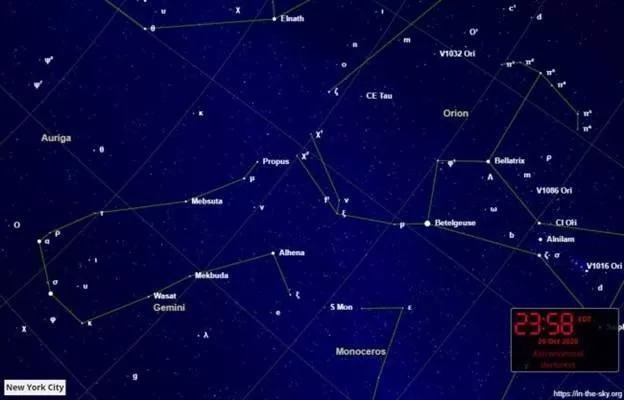Oct 20, 2020
The shower's radiant is located at the center of this stellar map, in the constellation of Orion, the hunter. - space.com
There's something enchanting about meteor showers according to space.com.
These light shows in Earth's celestial canopy show off just how dynamic and active our universe really is, with their dazzling flashes appearing faster than any other object in the night sky, like the movement of constellations or the passing shadow of a lunar eclipse.
Like the Eta Aquarids, the Orionid meteor shower is a by-product of Halley's Comet. In 2020 the Orionids will peak on the night of Oct. 20, with rates of about 10-20 meteors per hour.
The moon won't interfere because it will be in a crescent phase (about 23% full) and will dip below the horizon before the shower starts up.
This medium-strength shower can outburst and reach higher rates, but the Orionid meteor shower has produced "low to average displays" in recent years, according to AMS.
Related: Orionid meteor shower thrills skywatchers! See the photos
Where to see the Orionids
The 2020 Orionid meteor shower will have a period of activity from Oct. 2 to Nov. 7. It will peak on the night of Oct. 20-21. The shower's radiant is located at the center of this stellar map, in the constellation of Orion, the hunter.
These meteors should begin to appear around midnight local time, Cooke said.
Orionids are named for their radiant near the constellation Orion, which is one of the easier constellations to spot with the three stars that make up it's "belt." While you're viewing Orion, check out the red star Betelgeuse — it's been dimming over the last few months, and the astronomical community has been monitoring it closely in the event the dimming is a precursor to a supernova.
Bill Cooke, the lead for NASA's Meteoroid Environment Office, spoke with Space.com and offered skywatching tips and details on the major meteor showers visible this year.
"Meteor showers are an investment [of time]! Preparation is key to seeing them," Cooke said. "But it's cheap — just using your eyes will do." No telescope or binoculars are necessary, he said. "it's the simplest form of astronomy there is."
Meteor shower observing can't be done on a whim, but it's pretty straightforward: Get away from bright lights, take time to adjust your eyes to the dark night sky and avoid looking at your cellphone if you get bored. "You know, that's something about meteor observing: You let your eyes adapt to the dark, and what kills [meteor viewing for] most people nowadays is that they'll look at their phones, and that bright screen just totally trashes your night vision," Cooke said.
Give your eyes 30 to 45 minutes to adapt to the dark, he said, and take in as much of the sky as possible by lying down flat on your back. Meteors can appear anywhere in the sky, and the more sky you see, the better your chance is to spot one, he said. Each shower has a radiant, or a point in the sky where the meteors appear to originate. Knowing where the radiant is can be helpful, though the longer streaks will be visible farther away from the radiant.
Keep in mind that some sky conditions can impede successful viewing of shooting stars. Cloud coverage could block the sky, and the moon could also tarnish meteor shower viewing even on a clear night. Depending on the lunar phase, the amount of moonlight will wash out the faint meteors.
Sometimes meteor showers produce streaks that are exceptionally bright. Observers can occasionally spot fireballs, or meteors brighter than Venus, the brightest planet in the night sky. The rate of shooting stars can be higher than usual in some instances, too, when the stream of space rocks gets a gravitational "nudge" from the planet Jupiter.
Meteor showers happen when Earth passes through the debris field of a comet or asteroid as these objects make their way around the sun, shedding "crumbs" along the way. That's why a given meteor shower generally appears around the same time each calendar year. And occasionally, when the Jovian planet gets close to a stream of debris, its immense gravity perturbs the particles, nudging them slightly closer to Earth and thereby increasing the amount of meteors visible in the night sky. Occasionally, this can produce outbursts, or brief periods of intense activity in which skywatchers can see more than 1,000 meteors per hour.
Most annual meteor showers don't outburst, though, and are typically classified as strong, medium or weak showers, depending on their peak rates.
Share this article with friends!
Tags:
#orion,#shower,#orionid#meteor,#sky,#astronomy,#forecast,#starzpsychics,#starz#advisors

